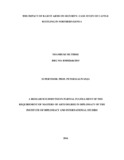| dc.description.abstract | The main objective of this study was to examine the impact of illicit arms on security: case study of cattle rustling in Northern Kenya. Specifically, the study sought to; critically examine the sources and historical roots underpinning the existence of illicit arms; investigate the impact of the SALWs on community commercialization of cattle rustling in Northern Kenya; assess the impact of illicit arms on various sectors in Kenya; and determine the solutions that have been tried by the government and community leaders to contain the challenges posed by illicit arms. The study adopted a qualitative research design compared to quantitative design. The population for this study constituted practitioners, policymakers, professionals because they were likely to be more knowledgeable and informative about the subject under investigation. Primary data was obtained from interviews. Secondary data was obtained from sources which included relevant published and unpublished materials on the research area. Data derived from both primary and secondary sources was valuated and analyzed in a systemic manner to determine the adequacy of information and the credibility, usefulness, consistency and validation of the hypothesis.
The study concluded that there are different sources and verifiable roots supporting SALWs increase including; lawful arms deals to untrustworthy governments, supply to revolt groups by a few nations, between tribal conflicts, various shipments of little quantities of weapons prompting to collection of substantial quantities of unlawful weapons, political insecurity in Africa, pastoralist groups regularly exchange steers for weapons, poor and degenerate policing of the borders amongst Kenya and its neighbors, the national law is not sufficiently upheld by Kenya police in their underestimated locales and in addition the result of the post-freedom Shifta strife realized by the presentation of cutting edge weaponry into northern Kenya.
The research likewise presumed that the twin marvels of SALWs and commercialization of dairy cattle rustling in northern Kenya has affected the general population of the area by making a domain of brutality and instability. It sum up to the fact that, that dairy cattle rustling has experienced key change from a social practice to a global business wander composed and bankrolled by cattle warlords.
Also the study inferred that illegal arms affect different areas in Kenya. Criminal exercises make harm property which negatively affect work, venture and development of post-struggle nations. In the northern outskirt areas of Kenya, relentlessly expanding episodes of furnished steers stirring, have driven pastoralist groups to reason that they ought to secure cutting edge programmed weapons. Programmed weapons have changed the substance of cattle mixing (otherwise called cows or domesticated animals assaulting) in Kenya's northern outskirt areas.
The study at long last inferred that East African nations are considering the illegal exchange SALW important, growing new enactment and characterizing national goals. However because of the absence of limit in the sub area, long-standing achievement can't be guaranteed. The chapter traced the control initiatives from the global perspective, the United Nations Programme of Action from which others seem to draw to facilitate the works of the global mechanism to the regional and national levels. The Bamako assertion is highlighted as a valid example of a territorial approach in managing small arms from which others shape at the sub provincial levels, for example, the Nairobi convention in the Great Lakes district and Horn of Africa to fortify the limit of the local component. These activities depict response from the huge risk the small arms and light weapons have postured and have generally been viewed as weapons of mass ownership. | en_US |



